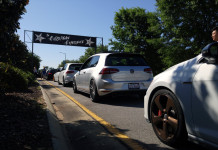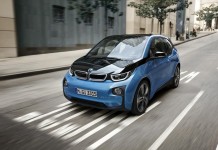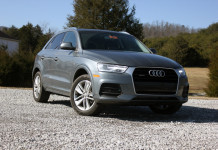AUDI AG is setting new standards in logistics: The carmaker is using trains powered by green electricity to transport its cars from Ingolstadt to the North Sea loading port of Emden, making it the first company in Germany to use green electricity in this way. This innovative logistics concept is a trailblazing step for the car industry and an important element of Audi’s strategy of ensuring that production is sustainable in all areas.
“CO2-free rail transport is an important element of our environmental efforts and is of great interest to us,” says Ernst-Hermann Krog, Head of Audi Brand Logistics. Beginning August 1, 2010, the carmaker is operating its transport trains on the Ingolstadt – Emden route with electricity from renewable energy sources. This allows Audi to eliminate the emission of around 5,250 tons of CO2 per year, more than 35 kilograms (77 lb) per car transported. The line to the North Sea loading port, the hub for overseas exports, is the brand’s most important transport route. Three trains loaded with Audi models travel this route each day and carry roughly 150,000 cars a year.
The CO2-free rail freight transport concept Eco Plus is a new offer from DB Schenker, the logistics area of German railway operator Deutsche Bahn. For transport within the domestic rail network, the energy required is replaced entirely by renewable energy from Germany. The electricity is bought in additionally by Deutsche Bahn, meaning that emissions are avoided right from the start. Eco Plus from DB Schenker and the energy supply are approved by TÜV SÜD.
The additional costs incurred compared to conventional electricity are borne by Audi; DB Schenker uses a portion of these for targeted projects in the field of renewable energies. Green electricity only comprises around 18.5 percent of the German rail electricity mix, with conventional energy sources in the form of coal-fired, nuclear and natural gas-fired power plants currently dominating. The green electricity required for transport is an additional component fed into the grid for Eco Plus from DB Schenker, thus the share of green electricity in Germany will increase.
Audi is the trailblazer in the car industry when it comes to the use of green electricity in rail freight. The premium manufacturer is working with DB Schenker as an early adopter and development partner. “The switch to CO2-free transport underscores our progressive character and sustainable mindset,” adds Ernst-Hermann Krog.
By train across Europe – efficient transport
Audi has relied on resource-efficient logistics for many years now. Up to 70 percent of all cars manufactured by the brand with the four rings arrive at their destinations by freight train. Many large components are also transported within the Volkswagen Group by rail.
Audi also uses the railroad for the high-volume traffic between the Ingolstadt and Györ sites. The painted bodies-in-white and add-on parts of the Audi TT depart Bavaria in closed, double-decker freight cars for assembly in northwestern Hungary. The finished cars then return to Ingolstadt over the same 610 kilometer long rail line, as do the engines assembled in Györ for the entire Audi model lineup.
Over the last 12 years, the trains have covered roughly ten million rail kilometers on the line between Györ and Ingolstadt, thus replacing more than 325,000 trips by truck. This represents an annual saving of 36,000 tons CO2. The high share of sustainably generated hydropower electricity in the Austrian rail system plays an important part in this good balance.
Where transport by truck is necessary, Audi pools shipments regionally within the Group network at so-called consolidation centers, so that the items can be transported to the plants with fully loaded trucks. This significantly reduces the number of road shipments and avoids unnecessary CO2 emissions.
The Logistics Center (GVZ), which houses numerous suppliers, was established in Ingolstadt in 1995. Key suppliers produce their assemblies there and deliver them directly to the assembly line according to the just-in-sequence principle. This close cooperation greatly reduces pollution due to the very short transport distances.
Less is more – resource-efficient Audi production
Audi places great value in all areas of the Company on maximum efficiency and resource conservation. In the logistics area, for example, the “PackAssistant” software ensures that the space in packing and containers is used optimally. The savings potential of up to 20 percent enables the elimination of numerous shipments from the supplier to the factory.
A major focus of Audi’s environmental activities is the reduction of energy consumption in car production. Taking the planned expansion of capacity into account, AUDI AG has stated the goal of reducing site- and company-specific CO2 emissions by 30 percent relative to 1990 by the year 2020. Overall energy consumption at the Audi Group has held steady for several years now, despite the significantly increased production volume.
The continuous improvement of the energy efficiency of the production facilities is very important in this context. Audi accomplishes this with new technologies, such as more efficient robots and new welding tongs, and with a large number of intelligent solutions. When engines are tested on the engine test rigs at the Neckarsulm site, for instance, generators are used to produce electricity, which is fed into the plant’s grid. The Company’s latest project is a particularly lightweight die for the body shop featuring carbon fiber composites in many areas. Developed in-house by Audi Toolmaking, it saves 43 percent electricity versus a conventional unit.
Intelligent – the energy supply
AUDI AG is also focused on resource efficiency when it comes to the supply of energy. Beginning in spring 2011, the use of waste heat from Ingolstadt’s waste utilization plant and from the Petroplus refinery will double from 60,000 to 120,000 megawatt hours per year. This represents potential CO2 savings of around 26,000 tons. A further expansion which will use 200,000 megawatt hours of waste heat is planned. The plant in Neckarsulm is also supplied with district heat.
In Ingolstadt, Audi has for years been producing roughly 100,000 megawatt hours of heat in its own highly efficient power-heat-cooling trigeneration plant, which also produces electricity and cooling energy. The remainder of the heat requirement is met using natural gas-fired boilers. Thermal wheels are used in many areas of the Company to recover heat; many hundreds of these units are deployed in Ingolstadt. The use of 19 heat recovery systems in the paint shop, for example, extracts approximately 35,000 megawatt hours per year, which corresponds to a CO2 reduction of around 7,000 tons.
Audi is also driving progress in the field of photovoltaics. The carmaker has made the roofs of numerous factory buildings at the Ingolstadt plant available to Munich-based Green City Energy. The photovoltaic modules installed there over an area of 11,600 square meters (124,900 square feet) produce more than 1,000 megawatt hours of electrical energy a year. An expansion of the photovoltaic surface area, including to the second German Audi site in Neckarsulm, is currently under review. And just a few months ago, Automobili Lamborghini, a subsidiary of the Audi Group, took a 17,000 square meter (183,000 square feet) solar power plant on line.
Beyond the factory gates – the Oak Forest research project
At Audi, environmental protection does not stop at the factory gates. In collaboration with the Bavarian State Forest Service and the Technical University of Munich, the Company has launched the “CO2 Reservoir Oak Forest” research project in the vicinity of the Ingolstadt plant. The project is focused on the scientific investigation of biological and ecological interrelationships. Audi planted roughly 36,000 Pendunculate Oaks for the project in 2008. A second trial site near the Györ production site in Hungary was planted with more than 13,000 oaks. Other sites are currently in planning.
The Company’s commitment is also manifest in the newly established Audi Environmental Foundation, which has been endowed with five million euros. The foundation’s aim is to protect the natural livelihood of people, animals and plants. It will fund measures and research activities that encourage the development of environmentally compatible non-automotive technologies, promote environmental education and contribute to a sustainable human/environment system.
Universal – environmental management at Audi
Sustainable business practices are an integral component of the Audi corporate strategy, in which environmental protection and innovation are linked. Audi has been awarded the European Union’s seal for outstanding environmental protection.
The Company is also involved within the framework of the 3rd Bavarian Environment Pact, which is dedicated to environment-friendly economic growth. Particularly high value is placed on the sharing of information with suppliers. The greater use of environmental protection strived for at the suppliers gives Audi greater influence on indirect environmental aspects by enabling the early development of holistic solutions.
The Audi Group is considered both in Germany and abroad to be one of the pioneers of site-specific environmental protection. EMAS (Eco Management and Audit Scheme), the demanding environmental management system of the European Union that far exceeds standard requirements, was installed in Ingolstadt (1997), Neckarsulm (1995), Györ (1999), Brussels (2002) and Sant’Agata Bolognese (2009), and has been steadily optimized in the interest of continuous improvement.
The Ingolstadt, Györ, and Sant’Agata Bolognese sites are also certified to the global standard DIN EN ISO 14001, which ensures continuous improvement of environmental protection performance. Furthermore, the environmental management system at the Ingolstadt plant has been certified to the European standard DIN EN 16001. This stipulates particularly stringent requirements for the steady and systematic reduction of energy consumption. The Audi plant in Ingolstadt was the first automobile plant to be awarded this certificate.
To conserve water resources, Audi is making greater use of rainwater at the Ingolstadt plant, where it is gathered over an area of 450,000 square meters (4,843,800 square feet), collected in five retaining pools and two storage sewers and forwarded to a treatment plant. The pools supplied more than 235,000 cubic meters (8,298,900 cubic feet) of process water in 2009.
Innovative and efficient – the products
When it comes to the products, Audi is further expanding its Vorsprung durch Technik with highly efficient TDI, FSI and TFSI engines and many new solutions from the modular efficiency platform. The lightweight construction of the Audi Space Frame reduces vehicle weight, and the aluminum bodies also enjoy major advantages in the overall energy balance and with recycling.
Audi is also concurrently hard at work on the development of alternative drive systems, with the Audi Q5 hybrid scheduled to debut next year. For a glimpse at the brand’s interpretation of the sustainable mobility of the future, one only need look at the Audi e-tron family, which features tailored concepts for each segment.







